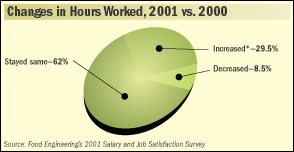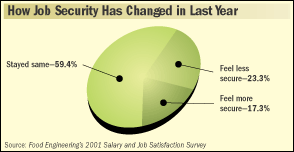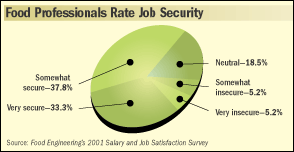the American food industry

When the yen was a monetary power in the 1980s and the Japanese economic engine was humming, the Nipponese job-for-life model was one of the distinctive features of Japan Inc.
Layoffs now are a fact of life in the Land of the Rising Sun, subjecting workers to the same uncertainty as their American counterparts. Although U.S. workers are more likely to be journeymen now than ever before, employment practices in food and beverage are a throwback to an earlier age. Line operators may come and go, but the men and women who run the plants often have long-term relationships with their employers.
That finding is suggested in Food Engineering's 2001 salary and job satisfaction survey, the 21st consecutive year that the magazine's readers have been polled on the topic. The results provide a useful benchmark of pay increases and attitudes in the food industry.
This year, readers were asked how many years they have worked in the food industry and how many they've worked for their current employer. The longevity marks were remarkably similar: while the average number of years in the food industry was 17 years, 9 months, the average tenure with respondents' current firm was 12 years, 8 months. Median durations -- the point at which half respondents were above and half below--were 16 years in the food industry and 10 years with their current employer.
Comparing responses to the two questions suggests there is little company-switching for the first 15 years that these food plant professionals work in the industry. Almost two-thirds of respondents who have worked 6 to 10 and 11 to 15 years in food processing have worked the same duration at their current employer. Wanderlust starts to set in after that, with almost half of veterans with 16 to 20 years experience reporting 10 years or less with their current employer. On the other hand, 43.8 percent of those with 21 to 25 years experience had worked a comparable period at their current employer; 56.7 percent with more than 25 years in the industry had also celebrated their silver anniversary with their current employer.
Food manager mobility is much greater than that at large food corporations, insists Bill Gladstone, division president of the recruitment firm Judge Group Inc., Bala Cynwyd, Pa. Front-line managers at those firms typically remain 2 to 5 years, he says. "Second-level managers stay a little longer, but a 5-to-10 year stint is high."
The job market for food professionals remains strong, despite the economy, Gladstone notes. Judge's food and pharmaceuticals division will handle $20 million in placements this year. The Southeast, Southwest and West remain bull markets-"That's where the new plants are being built," he points out-and he expects to place close to 200 food managers in California alone this year. Low mortgage rates help make job relocation more attractive, Gladstone adds.
For those not inclined to move, does contentment or atrophy cause them to stay? Probably more of the former than the latter, Food Engineering's survey suggests. Job satisfaction and security remain high. Another loyalty-builder is a salary structure that stacks up well compared to other manufacturing sectors. The majority of respondents earn more than $60,000 a year, and 71.2 percent earn $50,000 or better. Better than one in six have six-figure incomes, a proportion aided by the 13.4 percent of respondents who were company presidents.
In all, 135 food professionals participated in this year's survey, a 13.9 percent response rate. Surveys were mailed in mid-August, with a Sept. 19 cutoff for responses. Almost one in five survey respondents were women, giving this year's edition the broadest gender diversity ever, and 33 of the 48 contiguous states were represented in the returned questionnaires. The heaviest concentration was in the Midwest (38.9 percent of responses), followed by the South (27.8 percent), Northeast (22.2 percent) and West (11.1 percent). Three out of five work at companies with multiple locations, and more than a third work at firms with 5,000 or more employees.

Ka-ching, ka-ching
Food companies are not immune to the corporate belt-tightening that has accompanied this year's economic slowdown, but consumers stubbornly refuse to stop eating, and regularly scheduled pay raises are still forthcoming. Plant professionals report average annual pay increases of 4.1 percent, up from 3.9 percent in 2000. If workers who did not receive raises are factored out, pay hikes averaged 6.2 percent, with a median raise of 5 percent.Those benchmarks reflect an improvement over last year's survey results, when the medium increases was 4 percent. This year's gains help make up for ground lost last year, when food industry raises trailed private industry wage and salary increases of 4.1 percent. Overall compensation for U.S. private-industry workers dipped to 3.9 percent for the 12 months ending in June, down from 4.4 percent the previous year. In the manufacturing sector, raises were an anemic 3.5 percent, according to the U.S. Bureau of Labor Statistics.
Food professional's fatter paychecks will go further than they did in recent years. The U.S. Consumer Price Index for the 12 months ending in September is up only 2.6 percent. A year ago, the index was up 3.5 percent, leaving the typical Food Engineering reader with only a 0.4 percent gain in real income. This year's gain is 1.5 percent.
Based on a survey of compensation officers at 2,564 corporations, including 69 food & beverage firms, the good times should continue to roll into 2002. WorldatWork (formerly the American Compensation Association) says food & beverage companies are budgeting total salary increases of 3.9 to 4.5 percent. Nonunion hourly workers covered by the Fair Labor Standards Act of 1938 will be at the low end of that scale, with senior managers (CEOs, executive vice presidents) at the high end. Salaried workers fall between the extremes at about 4.4 percent.
Those projected increases were based on surveys mailed in the spring. _WorldatWork conducted a follow-up study in the wake of the Sept. 11 terrorist attacks in New York and the Pentagon (see related story).

Hard for the money
Any and all pay raises this year were well deserved, judging by time spent on the job. More than four out of five food professionals report working at least 45 hours per week, including 45 percent of the sample logging 50 to 60 hours and another 20.7 percent booking 60 hours-plus.A Puritan work ethic is nothing new in the food industry, though there is pressure to do more with less. Three in 10 respondents say the time required to perform their duties increased in the last year. In last year's Food Engineering survey, 73.5 percent claimed their workloads had increased, though they weren't asked if that translated to more hours on the job.
Responsibility for additional projects was the biggest contributor to expanded workloads, followed by responsibility for additional operational areas. Other key contributors to greater workloads were staff cuts in the department and management of additional personnel.
Last year, respondents indicated they had to sink or swim when workloads increased. The situation remains essentially the same, though 16.7 percent say they received on-the-job training to help them cope with added responsibilities, 13.3 percent attended workshops and short courses sponsored by professional associations and 10 percent benefited from formal in-house training programs.
Employers are trying different strategies to help workers cope with workloads. Bonuses and incentives are becoming more common rewards for added responsibilities. However, employers were less likely to create new positions to help employees meet increased production schedules. Partnering with other companies, outsourcing and hiring a consultant also appear less popular.
Companies were a little less likely to create new positions this year, with 27.9 percent of respondents saying their firms have done so, compared to 30.7 percent in the 2000 survey. The use of attrition to reduce staff sizes remains the strategy of choice at 15.6 percent of the respondents' companies, while 41 percent are filling vacancies but not adding new positions, down from 52.5 percent in 2000.
A sputtering Wall Street and slumping economy have put the brakes on corporate consolidation, but slightly more respondents to this year's survey indicated their company had been involved in a merger or acquisition in the last year (32.1 percent vs. 30.9 percent in 2000). M&A's impact also was virtually the same, with about two out of five saying a merger created new or expanded responsibilities and 35 percent saying a merger had no impact on their jobs. One in 10 said a merger produced worse working conditions, and one in 20 said salaries and benefits improved.
Innovation is critical if companies are to remain competitive, and innovation in cost reductions was the most frequently cited operational improvement, with 45.3 percent of respondents indicating their firms had innovated in this area. Better use of computer technology was another leading area of innovation, followed by packaging line improvements, processing system improvements and line extensions.
When innovation declined, budget cuts were the most likely culprit, followed by lack of support from upper management, time pressures and lack of training.

Satisfied and secure
Last year, three-quarters of respondents answered affirmatively to the question, "Are you satisfied in your current position?" This year, they were asked to rate their satisfaction on a five-point scale.Two-thirds indicated they were very or somewhat satisfied, while 14.1 percent indicated they were very or somewhat dissatisfied in their current positions. Satisfaction levels were highest among top management, with engineering-related workers reporting the lowest satisfaction levels (see related chart).
Job security levels were even higher, with 71.1 percent saying they were very or somewhat secure and only 10.4 percent rating themselves very or somewhat insecure. Only 17.3 percent said they felt more secure than they did a year ago, and 23.3 percent indicated they felt less secure.
When respondents were very satisfied in their jobs, they often cited the people they work with as the reason. When they were very dissatisfied, management was often the culprit.
"I enjoy my job and the folks I work with," wrote one very satisfied worker. "Less travel, got a great bunch of people to work with, enjoy community I live in," offered another. Challenging positions, job flexibility, a growing company and good compensation and benefits were other common themes. Several respondents attributed high satisfaction to the fact that they own the company.
"Communications problems, failure to appreciate effort spent, office backbiting" was at the root of one employee's dissatisfaction. "Not recognized or properly rewarded for work done" was an opinion shared by many. "Owner has no focus" and "lack of job security and poor management" were representative comments of very dissatisfied respondents.
More money, benefits and time off were frequently cited actions that companies could take to make workers more satisfied. Better communication and the tools to do a better job also ranked high on employees' wish lists.
"Many of the bigger companies are investing in automation and state-of-the-art equipment, and when it's working right, that helps retain people because they realize they're learning new skills and they feel good at the end of the day," points out recruiter Graldstone. "On the other hand, if a packaging machine is malfunctioning all day, a worker is going to go home frustrated and be more receptive to taking another job."
A better-trained and educated workforce was consistently recommended as a company action to improve efficiency, even moreso than adding staff. Updated technology, particularly in computerization, was another theme. "Less red tape" and "fewer corporate information requests for information readily available" were comments reflecting the views of several respondents, and sufficient funding to properly maintain operating systems was mentioned by others.
Manpower issues dominated comments on the most important workplace issue their firms face. Employee morale, retention and training came up repeatedly, as did "being able to communicate with an increasing Hispanic population." Competitive pressures and the economic downturn also are on food professionals' minds, judging by the comments.
Regulatory requirements are another concern, though government isn't the only contributor. "Keeping up with regulations imposed by clients and companies we supply" was mentioned by one respondent. Food safety remains the most important concern of many.
Travel to industry events and conferences is becoming a more common way for companies to recognize a job well done. The proportion of respondents citing this as an incentive more than doubled from last year to 14.3 percent. Event tickets and other non-monetary incentives grew in popularity, and fewer companies left it to individual managers or departments to recognize employees.
As in previous years, respondents to this year's Food Engineering Salary and Job Satisfaction Survey are a well-educated group representing a wide variety of food companies. Three in five have a college degree, including 16.8 percent with an advanced degree. Only one in 20 have no college experience.
Men accounted for 81.8 percent of the sample. Two out of five respondents work for single-plant processors, and one in five represent companies with more than 20 locations. While only 13.8 percent of respondents work at plants with more than 1,000 employees, 58.4 percent work for companies with total headcounts of 1,000 or more.
Sidebar1:
No consensus on most-admired food firm
While many of the food and beverage industry's most prominent companies were cited by survey respondents as the firms they most admire, no consensus pick emerged.This year's salary and job satisfaction survey included the open-ended question, "Other than your firm, what food or beverage company would you like to work for? What do you most admire about that firm?" Five of the world's 10 largest food companies merited mentions, but none stood head and shoulders above the pack.
Some of the less well-known mentioned included Sodexho, a food and facilities management company based in Gaithersburg, Md., poultry processor OK Foods and Hatfield Quality Meats in Pennsylvania. The "growth training" that Sodexho provides its 111,000 employees was cited by one respondent, while OK Foods' location in Heavener, Okla., appealed to another. "The way they take care of their people" bore mention regarding Hatfield.
In fact, good employee relations -- be it job security, professionalism or worker spirit -- was a frequently cited feature of the companies at which people would most like to work. "People are (JM Smucker's) most valuable asset," one person wrote, and another indicated "treat employees well" when citing Kraft. A global presence and growth potential also stood out as positive characteristics, as reflected in the comments about Coca-Cola, Nestle and H.J. Heinz's Starkist unit.
Companies garnering multiple mentions included Kraft and its Nabisco division, Nestle, Anheuser Busch, Hershey Foods, Coca-Cola and the PepsiCo holding company units Pepsi-Cola, Frito-Lay and Quaker Oats.

Sidebar2:
New World Disorder impacts future pay
The events of Sept. 11 carried an emotional and economic wallop, resulting in additional belt-tightening at many U.S. corporations.In a follow-up to its annual Total Salary Increase Budget Survey, an association of compensation managers found that one in four companies have revised their budgets downward since the terrorist attacks in New York and Washington, D.C. For example, when Scottsdale, Ariz.-based WorldatWork polled corporations in the spring, firms said salaried managers who are exempt from overtime and other provisions of the Fair Labor Standards Act were budgeted to receive 4.6 percent raises. Budgeted raises now average 3.2 percent.
"A marked decline has been witnessed in variable pay," including individual incentives and group/team awards, WorldatWork notes. However, "This reduction was more in reaction to the downturn in the economy, rather than the tragic events of Sept. 11." Exempt employees' variable pay budgets have gone from 10.1 percent hikes last year to 5.9 percent in 2001.
While 3 percent of corporations are cutting base-salary budgets. a similar proportion have increased those budgets since Sept. 11.

Subhead:
Training for Additional Responsibilities
None offered-40%Additional training not required-32.5%
Association courses, workshops-13.3%
College courses/academic workshops -4.2%
Computer/software training-5.8%
Formal in-house training-10%
Graduate level courses-1.7%
On-the-job training-16.7%
Vendor training programs-0.8%
Other - 4.2%
Note: Total exceeds 100% due to multiple answers
Source: Food Engineering's 2001 Salary and Job Satisfaction Survey